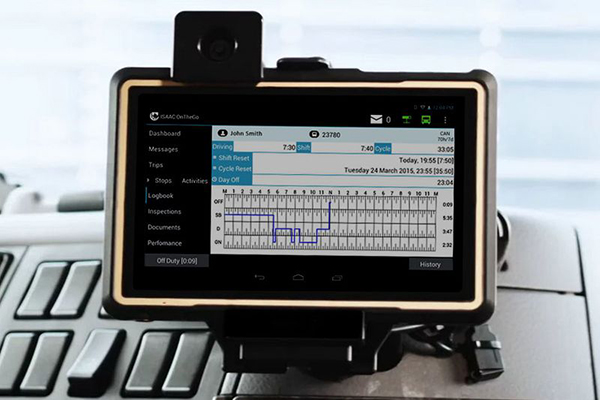Looming AOBRD deadline could negatively impact trucking capacity
A December 2019 deadline for adopting new systems for carriers to record truck drivers’ hours of service could cause a short-term blip in capacity as truckers convert to the new system.
At issue is a Department of Transportation regulation that makes Electronic Logging Devices (ELDs) stricter. Come Dec. 16, carriers no longer will be allowed to deploy the Automatic On-Board Recording Devices (AOBRDs) that were grandfathered in for the first two years of the ELD mandate.
Carriers with AOBRDs will need to switch to the more costly ELD system. Fleets will need to spend approximately $1,100 per truck for the new ELDs.
Donald Broughton, principal and managing partner of Broughton Capital who has decades of experience analyzing the trucking industry, says the next phase of the mandate beginning in December “may end up being just as disruptive” as when ELDs were first required in all trucks two years ago.
Broughton estimates that more than half of the 3.5 million Class 8 trucks now in use will be required to replace or significantly upgrade the ELD system they are currently using. That could force some big changes in driver behavior and in fleet operations, perhaps cutting into legal driving time.
The new ELD covers more than 3.7 million of smaller Class 3 through 7 trucks in commercial operation, including those operated by FedEx, UPS and smaller package delivery operations. According to Broughton’s estimates, he believes more than 60% of them will need to install a compliant ELD or risk fines.
Whatever happens in December is “a definite maybe,” according to Broughton. But leading trucking executives contacted by LM are split over the new mandate’s effect on capacity. Some said while costly, it is not a huge threat to capacity. Others said it might be.
“I don’t think it will affect capacity,” Jeff Mercadante, vice president of safety for Pitt Ohio, which has won the American Trucking Associations’ prestigious Presidents Trophy for safest fleet six times in the past 24 years. (Fleets can only enter every four years, so basically Pitt Ohio has won it every time it has entered).
Mercadante explained that the fleets affected by the changeover are mostly big companies “which were doing everything right before.”
Greg Orr, president of Joplin, Mo.-based CFI, a major truckload carrier, said his company is undergoing “a ton of training” to prepare for the switch. But he said a lot of technology providers might not be “prepared to flip the switch” to fleets can train drivers about the change prior to December.
“I think there will be some productivity losses,” Orr said. “I think it will be short term but it will depend on how well fleets train their drivers. But in the first 30-to-90 days there’s going to be some loss of productivity.
Generally, except for the cost, fleets are OK with the rules change. However, Mercadante explained, there can be pitfalls and a learning curve because of the change of technology.
Here’s an example: Like many trucking operations, Pitt Ohio “slip-seats” its trucks, meaning a linehaul driver will drive long distances at night, park the truck at a terminal where in the day time a city driver will make deliveries during the day. But at times, the truck is moved several hundred yards at a terminal.
Recently Pitt Ohio had a city driver enter the truck that had routinely moved on the lot and the system asked, “Do you want to accept drive time?” Mistakenly, the driver responded yes. That erroneously started his 11-hour driving limit at a much earlier time when, in fact, the truck was not in operation.
“We run by the rules and regulations and we don’t make exceptions,” Mercadante explained. “But that day the driver lost a whole day’s pay, and we didn’t have a city driver that day.”
So as the deadline approaches, fleets are advised that the switch to ELDs from AOBRDs requires more than just flipping of a switch. Experts say training is mandatory.













